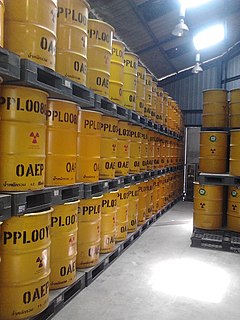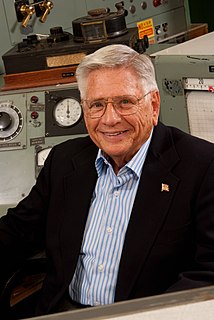Related Research Articles

Radioactive waste is a type of hazardous waste that contains radioactive material. Radioactive waste is a result of many activities, including nuclear medicine, nuclear research, nuclear power generation, rare-earth mining, and nuclear weapons reprocessing. The storage and disposal of radioactive waste is regulated by government agencies in order to protect human health and the environment.

The United States Department of Energy (DOE) is an executive department of the U.S. federal government that oversees U.S. national energy policy and manages the research and development of nuclear power and nuclear weapons in the United States. The DOE oversees the U.S. nuclear weapons program, nuclear reactor production for the United States Navy, energy-related research, and domestic energy production and energy conservation.

The Yucca Mountain Nuclear Waste Repository, as designated by the Nuclear Waste Policy Act amendments of 1987, is a proposed deep geological repository storage facility within Yucca Mountain for spent nuclear fuel and other high-level radioactive waste in the United States. The site is on federal land adjacent to the Nevada Test Site in Nye County, Nevada, about 80 mi (130 km) northwest of the Las Vegas Valley.

The Waste Isolation Pilot Plant, or WIPP, is the world's third deep geological repository licensed to store transuranic radioactive waste for 10,000 years. The waste is from the research and production of United States nuclear weapons only. The plant started operation in 1999, and the project is estimated to cost $19 billion in total.

Bullfrog County was an uninhabited county in the U.S. state of Nevada created by the Nevada Legislature in 1987. It comprised a 144-square-mile (370 km2) area around Yucca Mountain enclosed by Nye County, from which it was created. Its county seat was located in the state capital of Carson City 270 miles (430 km) away, and its officers were appointed by the governor rather than elected.

The environment of Nevada comprises diverse biotas, climates, and geologies. Environmental regulations and the environmental movement have aimed to respond to environmental threats.

The Energy Policy Act of 1992, effective October 24, 1992, is a United States government act. It was passed by Congress and set goals, created mandates, and amended utility laws to increase clean energy use and improve overall energy efficiency in the United States. The Act consists of twenty-seven titles detailing various measures designed to lessen the nation's dependence on imported energy, provide incentives for clean and renewable energy, and promote energy conservation in buildings.

The Nuclear Waste Policy Act of 1982 is a United States federal law which established a comprehensive national program for the safe, permanent disposal of highly radioactive wastes.

A deep geological repository is a way of storing hazardous or radioactive waste within a stable geologic environment. It entails a combination of waste form, waste package, engineered seals and geology that is suited to provide a high level of long-term isolation and containment without future maintenance. This will prevent any radioactive dangers. A number of mercury, cyanide and arsenic waste repositories are operating worldwide including Canada and Germany and a number of radioactive waste storages are under construction with the Onkalo in Finland being the most advanced.

Area 25 is the largest named area in the Nevada National Security Site at 254 square miles (660 km2), and has its own direct access from Route 95. Area 25 is commonly called "Jackass Flats" because it is composed primarily of a shallow alluvial basin by that name.

Yucca Mountain is a mountain in Nevada, near its border with California, approximately 100 miles (160 km) northwest of Las Vegas. Located in the Great Basin, Yucca Mountain is east of the Amargosa Desert, south of the Nevada Test and Training Range and in the Nevada National Security Site. It is the site of the Yucca Mountain nuclear waste repository, which is currently identified by Congressional law as the nation's spent nuclear waste storage facility. However, while licensure of the site through the Nuclear Regulatory Commission is ongoing, political maneuvering led to the site being de-funded in 2010.

High-level radioactive waste management concerns how radioactive materials created during production of nuclear power and nuclear weapons are dealt with. Radioactive waste contains a mixture of short-lived and long-lived nuclides, as well as non-radioactive nuclides. There was reportedly some 47,000 tonnes of high-level nuclear waste stored in the United States in 2002.

J. Samuel Walker is an American historian and author based in Maryland, most notable for his research and writing on the nuclear age, both weaponry and atomic energy. Several of his books have earned broad-based critical acclaim and advanced novel viewpoints. Despite affiliation with government and the nuclear industry, he is cited by the peace movement and parties who are highly critical of nuclear energy.
Radioactive waste is generated from the nuclear weapons program, commercial nuclear power, medical applications, and corporate and university-based research programs. Some of the materials LLW consists of are: "gloves and other protective clothing, glass and plastic laboratory supplies, machine parts and tools, and disposable medical items that have come in contact with radioactive materials". Waste is generally categorized as high level waste (HLW) and low-level waste (LLW). LLW contains materials such as irradiated tools, lab clothing, ion exchanger resins, animal carcasses, and trash from defense, commercial nuclear power, medical, and research activities. These materials usually have radioactivity that have short half lives—from ranges of multiple days to several hundred years. In 1990, 1.1 million cubic feet of LLW was produced. Currently, U.S. reactors generate about 40,000 cubic meters of low-level radioactive waste per year, including contaminated components and materials resulting from reactor decommissioning.
In general, Nuclear policy of the United States refers to the policies of the various agencies and departments of the American government at the Federal level with regard to biomedical, energy, emergency response, hazardous waste transport and disposal, military, use of radionuclides including US policy with regard to its participation in international treaties, conventions and organizations. Nuclear policy of the United States may also include management and regulation of nuclear levels in air, food, ground water and other potentially hazardous sources.
The U.S. Nuclear Waste Technical Review Board was established in the 1987 Nuclear Waste Policy Amendments Act (NWPAA) to "...evaluate the technical and scientific validity of activities [related to managing and disposing of spent nuclear fuel and high-level radioactive waste] undertaken by the Secretary [of Energy], including
- site characterization activities; and
- activities relating to the packaging or transportation of high-level radioactive waste or spent nuclear fuel."

Basin and Range National Monument is a national monument of the United States spanning approximately 704,000 acres of remote, undeveloped mountains and valleys in Lincoln and Nye counties in southeastern Nevada. It is described as "one of the emptiest spaces in a state famous for its emptiness."
Journey to the Safest Place on Earth is a 2013 documentary film written and directed by Edgar Hagen. It discusses the huge quantity of radioactive waste and spent fuel rods being stored at various locations on the planet.

A Blue Ribbon Commission on America's Nuclear Future was appointed by President Obama to look into future options for existing and future nuclear waste, following the ending of work on the incomplete Yucca Mountain Repository. At present, there are 70 nuclear power plant sites where 65,000 tons of spent fuel is stored in the USA. Each year, more than 2,000 tons are added to this total. Nine states have "explicit moratoria on new nuclear power until a storage solution emerges". A deep geological repository seems to be the favored approach to storing nuclear waste.

Robert Louis (Bob) Ferguson was a nuclear-trained physicist and a 60-year veteran in the field of nuclear energy. He was best known for being appointed the first Deputy Assistant Secretary for Nuclear Energy Programs for the U.S. Department of Energy (DOE) by the first Energy Secretary, James Schlesinger, serving from 1978 to 1980 during President Jimmy Carter's administration.
References
- ↑ "STATE DEPARTMENTS - AGENCIES". Archived from the original on 2007-06-07. Retrieved 2007-06-27.